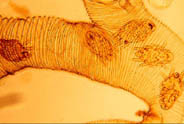Tracheal mites (Acarapis woodi) were first found in the United States in 1984 in the state of Texas, and have continued to spread and are still a problem to this day.
THE SPREAD OF TRACHEAL MITES
The mites live in the tracheal tubes (breathing airways) of honey bees, a heavy infestation results in bees that don’t live nearly as long and their production is cut short. The mites are transferred from bee to bee within the hive rather quickly once an infestation is established. Once an infestation occurs it’s not long before every colony in an apiary is effected. Once a bee colony is infested it remains infested with mites, although the numbers fluctuate during the year with the highest level during the winter.
The tracheal mite can be very difficult to detect – in fact, most don’t realize their hives are infected until there are heavy losses over the winter.
TRACHEAL MITE LIFE CYCLE

The life cycle of the mite is spent within the breathing tubes (trachea) of adult honey bees with the exception of a short migratory period where they can be found in the hive. Mites can also be found in air sacs in the thorax and abdomen. While in the breathing tubes, the mite will reproduce and feed. They feed on blood of their host bee. Normally both tracheal tubes of an infected bee will contain a few adult mites and eggs. Also as a result of mite feeding, the blood of infested bees has a higher than normal bacterial count.
Female mites will migrate into the trachea of a newly emerged worker bee by passing through the first thoracic spiracle and stay there until either they or the bee dies. Female mites can lay eggs throughout their entire lives. Eggs hatch in 3 or 4 days. Basically their life cycle is like this: egg -> larvae -> resting stage -> adulthood.
Mites are spread as a result of bee-to-bee contact, mated female mites leave the trachea and climb to the tip of a body hair. As bees come in contact with one another, the mites will transfer themselves to a passing bee via the hairs and enter the tracheae through the thoracic spiracles. It’s important to note that mites can only live 24 hours once they are out of the tracheal tubes. Once a bee dies the mites will emerge and look for a new host. Obviously, bees drifting between hives and apiaries are how they are spread.
TRACHEAL MITE CONTROL
As far as chemical treatments go, menthol crystals are the only approved treatment for tracheal mites in the United States. Menthol is commonly used in items such as cough drops, candies, cigarettes, and shaving creams.
Menthol is a crystal and starts to evaporate at approximately 70°F and becomes a liquid at approximately 102-105°F. The vapors, which start to come off the crystals at 70°F, are heavy, so will settle down onto the bottom of the hive. The best evaporation rate occurs between 80 and 85°F.
The best time to treat for tracheal mites is in the spring when the weather is warm and in the fall after the honey harvest. If using a bottom entrance an entrance reducer should be set to the smallest opening possible to help keep the menthol vapors in the hive. Menthol vapors are heavy, and keeping the entrance small will reduce vapor loss. The honey bees must continually inhale menthol for a period of 15 days (no more than 25 days) in order to bring the mites under control.
A packet of menthol crystal pellets should be placed on top of the brood chamber and on the top bars, either over the cluster in cool to moderate weather or off to one side in hot weather. Pellets should be arranged as flat as possible in a packet to avoid lumps. This will improve the evaporation of the crystals.
On the non chemical side of things, grease patties are a home made solution that has been in use for some time, the most common formulas are:
1 lb. vegetable shortening (such as Crisco®)
2 lbs. granulated sugar
or
1 lb. vegetable oil
3 lbs. granulated (or powdered) sugar
The grease/oil and sugar needs to be blended well so the patty doesn’t crumble. Grease patties should be used in early spring and again in the fall for best results.
BREEDING FOR RESISTANCE
This is easier said than done but the best way to treat for tracheal mites is to breed resistance into your bees. How is this done? Simple, stop treating and raise your own queens. You will have losses but as your apiary grows, the bees will have a natural resistance…






I look forward to every blog. I do not raise bees anymore because of age but I still think they are one of God’s most amazing creations! Keep the articles coming. Thank You
This summer I installed a feeding tray in my hive. I placed it on top of the highest super, filled it with sugar water, and then placd a deep hive box and cover on top of that. It was three weeks before I checked it, and found th whole tray filled with two inches of dead bees.
What went wrong?
Thanks Bonnie, Glad you enjoy the articles 🙂
Stan, it sounds to me like the bees are drowning in the syrup. Try floating a piece of wood or Styrofoam in your feeder, this will give the bees something to stand on while feeding. I’ve never tried it, but I have heard of others using folded up window screen pushed into the feeder to let the syrup come through. The bees can stand on it while feeding…
Hope that helps!
Thanks 4 the articles.
I’m new in bee keeping, just started this year with one small hive with two entrance but suprisingly when the hive colonize, one of the entrance was blocked and as well created small holes of about three into the second entrace which they use for theri entry and exit. Is this right? If yes why the blocking and small holes created.
One the other hand l learnt that those bees are feeding on Palm Trees on the farm bcos we have them plenty on the farm. Is this good for their feeding.
Pls. I will like to read more article on bee especially those meant for begginners. thanks.
Thanks Daud, glad you enjoyed the article. When there is more than one entrance, the bees will close up the holes and make a smaller entrance to make it easier to defend against intruders or robbing…that is most likely what is happening with your hive.
I don’t see a problem with the flowering palm trees…
Hope that helps!
Hi Charles I just started beekeeping a year and a half ago I have 8 hives out of 11 I lost 3 to wax moth. All 3 had screened bottom board. I am wandering if that had anything to do with it one hive was strong enough to defend itself but i notice all 3 had cocoons under the screen I enjoy your articles and would like your coment Thanks
Hi Essie, glad you enjoy the articles 🙂
There is a higher probability of wax moths with the use of screened bottom boards (sbb) as pieces of wax will fall through and accumulate but your bees should be able to defend against them fairly easily. Is it possible that you have too much room in the hives and the bees can’t keep up? A good rule of thumb is to place a new super only after they have filled 80% of the top super.